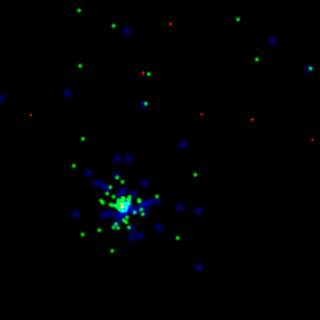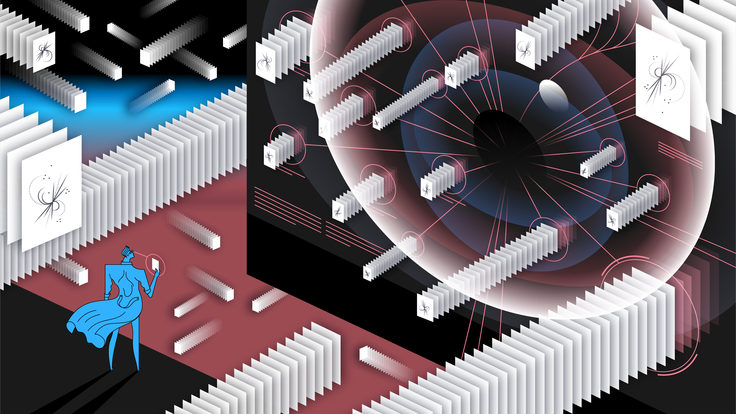
GRB 080916C's X-ray afterglow appears orange and yellow in this view that merges images from Swift's UltraViolet/Optical and X-ray telescopes. Credit: NASA/Swift/Stefan Immler
A paper published today in Science Express details the most extreme gamma-ray blast ever observed, seen by the Fermi Gamma-ray Space Telescope. While I am sure this will make plenty of news around the world, the aspect I find most interesting isn't the mere superlative native of the blast, but the science that comes from it.
In particular, the details of the blast place the tightest constraints yet on the constancy of the speed of light at different energies. This is important for the development of theories of quantum gravity, as many flavors of those theories predict that the speed of light does actually change with the frequency/color/wavelength of light. (So far, there has been no experimental evidence to suggest the speed of light changes, but it is possible for there to be small changes in the speed of light, consistent with everything that has ever been observed.)
The gamma rays from the burst came in spread out over 16.5 seconds. This time delay could be due to gamma-rays being emitted from different regions of space, some slightly closer to us than others. However, assuming that the gamma rays were all emitted from the same place at the same time, this spread of arrival times gives a maximum speed difference between the different gamma-ray energies. Doing the most conservative calculation possible shows that any change in the speed of light must be no more than a certain limit, and that limit is the tightest yet measured. (The assumption that the gamma rays come from the same place makes the constraint the most conservative, rather than invalidating this kind of conclusion.)

This movie compresses about 8 minutes of Fermi LAT observations of GRB 080916C into 6 seconds. Colored dots represent gamma rays of different energies. Visible light has energy between about 2 and 3 electron volts (eV). The blue dots represent lower-energy gamma rays (less than 100 million eV); green, moderate energies (100 million to 1 billion eV); and red, the highest energies (more than 1 billion eV). Credit: NASA/DOE/Fermi LAT Collaboration
Interestingly, this technique could be used to search for changes in the speed of light, called Lorentz violation in the argot. If the spread is due to spatial separation of the bursting elements, then the time delay between the start and end of the burst should not depend on the distance of the burst from us. However, if the speed of light varies, then we would expect the time delay to increase for bursts further away. The Fermi Gamma-ray Space Telescope will be in an excellent position to measure many of these bursts and collect precisely this kind of data.
Because the geometric layout of bursts isn't well understood, nobody will be rushing to suggest that this technique can identify Lorentz violation. However, by doing these studies, the contraints on how much Lorentz violation could possible exist will get tighter and tighter, perhaps tight enough to rule out some theories of quantum gravity.
The press release issued by SLAC National Accelerator Laboratory is as follows:
Most extreme gamma-ray blast ever, seen by Fermi Gamma-ray Space Telescope
With the greatest total energy, the fastest motions, and the highest-energy initial emissions ever before seen, a gamma-ray burst recently observed by the Fermi Gamma-ray Space Telescope is one for the record books. The spectacular blast, which also raises new questions about gamma-ray bursts, was discovered by the FGST's Large Area Telescope, a collaboration among NASA, the US Department of Energy (DOE) Office of Science and international partners.
"Burst emissions at these energies are still poorly understood, and Fermi is giving us the tools to figure them out," says Large Area Telescope Principal Investigator Peter Michelson, a Stanford University physics professor affiliated with the Department of Energy's SLAC National Accelerator Laboratory.
The explosion, designated GRB 080916C, occurred at 7:13 p.m. EDT Sept. 15 (after midnight GMT, Sept. 16) in the constellation Carina. FGST's other instrument, the Gamma-ray Burst Monitor (GBM), simultaneously recorded the event. Together, the two instruments provide a view of the blast's gamma-ray emission from energies ranging from 3000 to more than 5 billion times that of visible light.
A team led by Jochen Greiner at the Max Planck Institute for Extraterrestrial Physics in Garching, Germany, established that the blast occurred 12.2 billion light-years away using the Gamma-Ray Burst Optical/Near-Infrared Detector (GROND) on the 2.2-meter telescope at the European Southern Observatory in La Silla, Chile.
"Already, this was an exciting burst," says Julie McEnery, an FGST deputy project scientist at NASA's Goddard Space Flight Center in Greenbelt, Maryland. "But with the GROND team's distance, it went from exciting to extraordinary."
With the distance in hand, FGST team members showed that the blast exceeded the power of nearly 9,000 ordinary supernovae and that the gas bullets emitting the initial gamma rays must have moved at no less than 99.9999 percent the speed of light. This burst's tremendous power and speed make it the most extreme recorded to date.
The burst is not only spectacular but also enigmatic: a curious time delay separates its highest-energy emissions from its lowest. Such a time lag has been seen clearly in only one earlier burst, and researchers have several explanations for why it may exist.
The environment around a gamma-ray burst is extremely complicated. Although the specifics vary from burst to burst, the surrounding area generally includes the remnants of a stellar explosion, a magnetic field, a black hole and various particles accelerated by the black hole's gravitational pull, as well as huge amounts of radiation. It is possible that the delays could be explained by the structure of this environment, with the low- and high-energy gamma rays "coming from different parts of the jet or [being] created through a different mechanism," Michelson says.
Another, far more speculative theory posits that perhaps time lags result not from anything in the environment around the black hole, but from the gamma rays' long journey from the black hole to our telescopes. If the theorized idea of quantum gravity is correct, then at its smallest scale space is not a smooth medium but a tumultuous, boiling froth of "quantum foam." Lower-energy (and thus lighter) gamma rays would travel faster through this foam than higher-energy (and thus heavier) gamma rays. Over the course of 12.2 billion light years, this very small effect could add up to a significant delay.
The FGST results provide the strongest test to date of the speed of light's consistency at these extreme energies. As FGST observes more gamma-ray bursts, researchers can look for time lags that vary with respect to the bursts. If the quantum gravity effect is present, time lags should vary in relation to the distance. If the environment around the burst origin is the cause, the lag should stay relatively constant no matter how far away the burst occurred.
"This one burst raises all sorts of questions," Michelson says. "In a few years, we'll have a fairly good sample of bursts, and may have some answers."
The team's results appear in the February 19 edition of Science Express.
Gamma-ray bursts are the universe's most luminous explosions. Astronomers believe most occur when exotic massive stars run out of nuclear fuel. As a star's core collapses into a black hole, jets of material-powered by processes not yet fully understood-blast outward at nearly the speed of light. The jets bore all the way through the collapsing star and continue into space, where they interact with gas previously shed by the star. This generates bright afterglows that fade with time.






